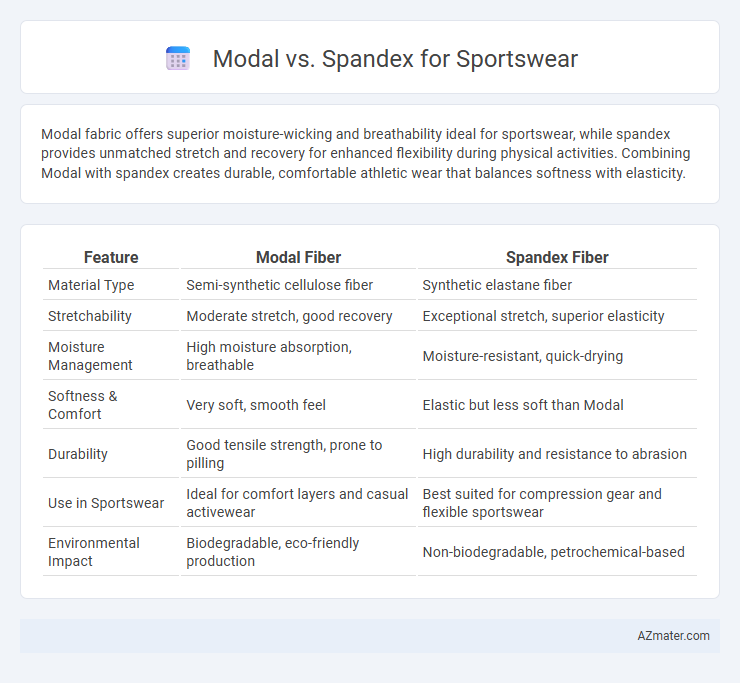Modal fabric offers superior moisture-wicking and breathability ideal for sportswear, while spandex provides unmatched stretch and recovery for enhanced flexibility during physical activities. Combining Modal with spandex creates durable, comfortable athletic wear that balances softness with elasticity.
Table of Comparison
| Feature | Modal Fiber | Spandex Fiber |
|---|---|---|
| Material Type | Semi-synthetic cellulose fiber | Synthetic elastane fiber |
| Stretchability | Moderate stretch, good recovery | Exceptional stretch, superior elasticity |
| Moisture Management | High moisture absorption, breathable | Moisture-resistant, quick-drying |
| Softness & Comfort | Very soft, smooth feel | Elastic but less soft than Modal |
| Durability | Good tensile strength, prone to pilling | High durability and resistance to abrasion |
| Use in Sportswear | Ideal for comfort layers and casual activewear | Best suited for compression gear and flexible sportswear |
| Environmental Impact | Biodegradable, eco-friendly production | Non-biodegradable, petrochemical-based |
Understanding Modal and Spandex: Key Differences
Modal fabric, derived from beech tree cellulose, is known for its softness, breathability, and moisture-wicking properties, making it ideal for lightweight sportswear. Spandex, a synthetic fiber made from polyurethane, offers exceptional stretch and shape retention, crucial for compression and flexibility in athletic apparel. While Modal enhances comfort and natural feel, Spandex provides elasticity and durability, often blended to optimize performance in sportswear.
The Science Behind Modal Fabric
Modal fabric, derived from beech tree cellulose, offers exceptional moisture-wicking and breathability due to its semi-synthetic fiber structure, making it ideal for sportswear that requires quick drying and comfort. The fiber's smooth surface enhances softness and reduces friction against the skin, preventing irritation during intense physical activities. Modal's high tensile strength and resistance to shrinking and pilling ensure durability and maintain fabric integrity under repeated use and wash cycles in athletic environments.
Spandex: The Stretch Revolution in Sportswear
Spandex, also known as Lycra or elastane, revolutionizes sportswear by offering exceptional stretch and recovery, providing athletes with enhanced mobility and comfort. Its ability to retain shape and resist sweat makes it an ideal fabric in high-performance activewear, outperforming Modal in flexibility and durability. This stretch fabric is essential in sportswear design, ensuring garments move seamlessly with the body during intense physical activity.
Moisture-Wicking Capabilities: Modal vs Spandex
Modal fabric exhibits superior moisture-wicking properties compared to Spandex, efficiently absorbing and releasing sweat to keep athletes dry during intense workouts. Spandex primarily provides elasticity and stretch but has limited moisture management, often requiring blending with other fibers to enhance breathability. Choosing Modal-rich sportswear improves comfort by enhancing ventilation and reducing moisture buildup in activewear.
Breathability and Comfort: Which Fabric Wins?
Modal fabrics offer superior breathability due to their moisture-wicking properties, making them highly effective at keeping athletes cool and dry during intense workouts. Spandex excels in comfort by providing exceptional stretch and flexibility, allowing unrestricted movement without sacrificing fit. For sportswear, choosing between Modal and Spandex depends on prioritizing breathability or elasticity, with many performance garments combining both for optimal comfort and ventilation.
Durability in Activewear: Modal Compared to Spandex
Modal fibers offer excellent durability in activewear, maintaining strength and shape retention even after multiple washes and intense physical activities. Spandex provides superior elasticity, allowing for greater stretch and recovery, but may degrade faster under constant friction and exposure to sweat over time. Combining Modal and Spandex in sportswear creates a balanced fabric with both long-lasting durability and flexible performance ideal for active use.
Eco-Friendliness: Sustainability of Modal and Spandex
Modal fibers are derived from sustainably sourced beech trees, making them biodegradable and more environmentally friendly compared to synthetic Spandex, which is petroleum-based and non-biodegradable. Spandex production involves significant chemical processing and releases pollutants, whereas Modal manufacturing uses less water and energy, contributing to lower carbon emissions. Choosing Modal for sportswear enhances eco-friendliness due to its renewable raw materials and reduced environmental impact throughout its lifecycle.
Fit and Flexibility: How Modal and Spandex Respond to Movement
Modal fabric offers a soft, breathable fit that gently contours the body, providing comfort during low to moderate activity levels, but it lacks the stretch recovery needed for high-intensity movement. Spandex excels in flexibility and elasticity, allowing sportswear to stretch extensively and return to its original shape, ensuring optimal freedom of movement and maintaining a snug fit during rigorous exercise. Combining Modal with Spandex often results in sportswear that balances comfort, moisture-wicking properties, and superior stretch responsiveness for diverse athletic activities.
Common Sportswear Applications: Modal vs Spandex
Modal fabric offers exceptional breathability and softness, making it ideal for yoga pants and low-impact sportswear where comfort and moisture-wicking are essential. Spandex excels in high-stretch applications like compression gear, cycling shorts, and running apparel due to its superior elasticity and shape retention. Both fabrics are often blended with other fibers to optimize performance characteristics for specific sportswear needs.
Choosing the Best Fabric for Your Athletic Needs
Modal offers exceptional softness and moisture-wicking properties, making it ideal for light-impact sportswear where comfort and breathability are priorities. Spandex provides superior elasticity and shape retention, essential for high-intensity workouts requiring maximum flexibility and support. Choosing between Modal and Spandex depends on the specific athletic activity, with Modal enhancing comfort and Spandex ensuring durability and stretch.

Infographic: Modal vs Spandex for Sportswear
 azmater.com
azmater.com